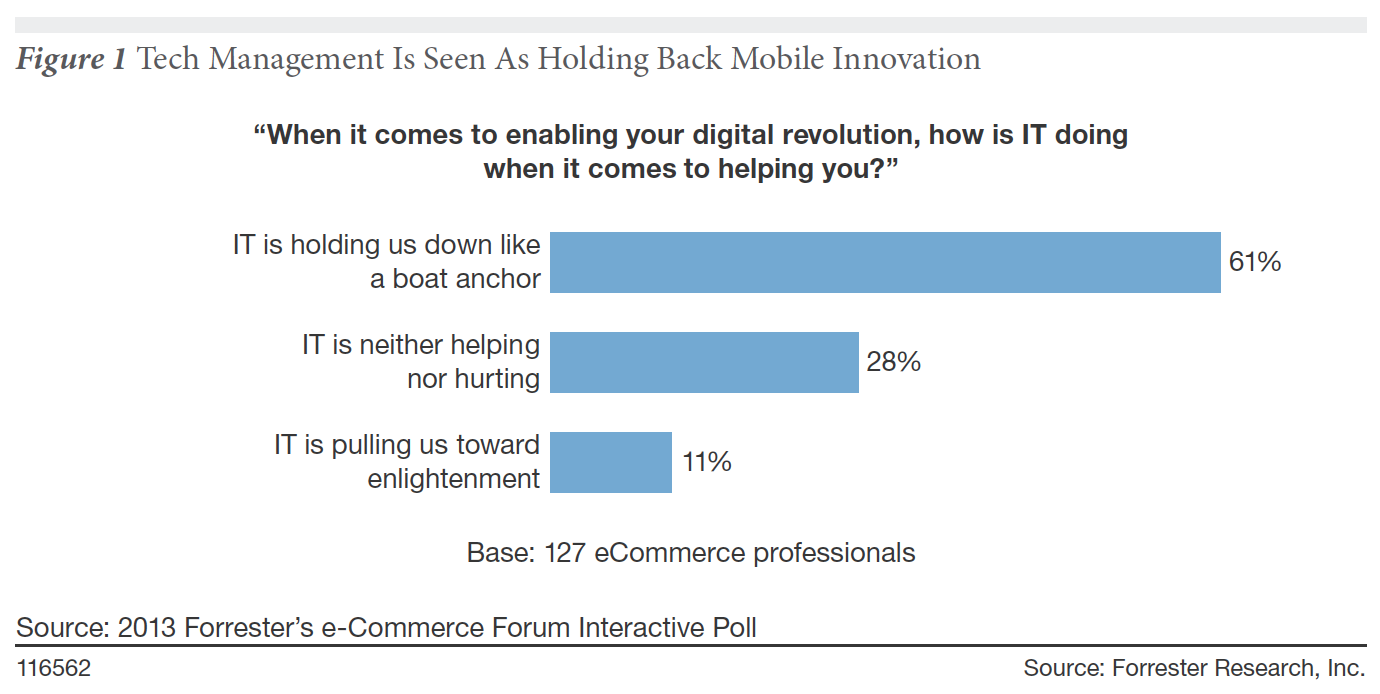
Pity the IT professionals. For years they’ve been bludgeoned for allegedly obstructing enterprise innovation. But in the increasingly mobile world, that “bludgeoning” is about to hit overdrive.
According to a recent Forrester report (“Developers Are The St. Bernard For Mobile Projects“), there are four key ways that IT blocks mobile innovation. As power within the enterprise quickly gravitates to developers, IT needs to remedy these roadblocks if it wants to avoid a pink slip.
The gist? IT needs to learn to become a heck of a lot more agile.
Slow And Steady
The bigger the enterprise, the more the tendency to want to maximize economies of scale and minimize IT complexity. As Forrester notes in its report, this leads to some understandable behaviors that turn out to be inimical to innovation.
See also: Shadow IT: Bigger, Less Manageable And More Important Than You Think
Worse, these behaviors are also driving a serious wedge between IT organizations and the business leaders that have traditionally depended upon them:

When only 11% of survey respondents see IT as more helpful than hurtful, IT has a massive credibility chasm to fill. As such, many on the business side simply route around IT, which is why shadow IT has exploded.
None of which bodes well for the future of IT. Small wonder, then, that Gartner sees 38% of business technology spending already happening outside IT, a percentage that will jump to 50% by 2017.
How Did IT Go So Wrong?
It’s not really IT’s fault. After all, IT has for years simply tried to save the enterprise money and drive standardization. As Forrester acknowledges “tech management shops excel in limiting complexity by setting long-lived standards and minimizing the number of vendors, frameworks, and configurations they developers may use,” which sounds great.
The problem, as the report goes on to state, is “That strategy doesn’t mesh well with innovation projects that require experimentation with new technologies or rapidly evolving customer choices of technologies.”
According to Forrester, there are four primary ways that IT’s quest to control leads companies to mismanage their mobile strategy:
- Architecture groups favor standardization over innovation
- Software delivery teams don’t support continuous delivery of mobile apps
- Tech organizations are understaffed
- Tech leaders focus on projects, not products
Summed up, IT organizations still treat applications as one-off projects with predictable, slow-and-steady release cycles. They treat technology as something that can be outsourced, rather than something that is fundamental to business success. As Forrester concludes, “the iterations and cycling on core mobile apps should come from an in-house product team, goaled on the ongoing success of the app as a product.”
Developers Light The Way
IT’s loss has been developers’ gain, and it’s not clear IT will ever regain its status. Indeed, Forrester sees developers taking on the primary role for channeling technology into an organization, because they’re so closely aligned with the line of business:
To cross the innovation chasm, senior business leaders must decide to treat mobile like the other products and services the company offers to customers, but with one important exception: Customers expect the pace of new feature rollouts and service releases to be far faster than for any other product. Identifying customer needs and synching product delivery workflows quickly can only be done well through close and ongoing collaboration between developers and their business counterparts.
This partnership between the developer and line of business is expected to become even tighter as developers leave IT behind:
Developers must seek out well-placed allies in business units outside centralized tech management groups. While a small group of developers may not have enough budgetary discretion to bring prototype ideas to fruition, business leaders do — but they generally lack the “maker” skills and time to act on their ideas. Sometimes all it takes is one enlightened business executive and one motivated developer to get things rolling — even if it’s outside normal business hours and traditional reporting relationships.
Forrester goes on to provide the business and the developers advice on how to make the partnership work, but the crux of it is this: developers are the new kingmakers, as Redmonk has been saying for years. Unless enterprises find ways to unleash the creativity of their developers, they will fail.
While this doesn’t mean IT’s role should be eliminated, it does mean that enterprises need to find ways to marry the best of developers (creativity, fast iteration) with the best of IT (stability, predictability). The two need not be oil and water, but the onus is on IT to change, because increasingly developers are coding the future of their enterprises.
Lead image courtesy of Shutterstock





















